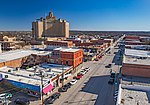First Presbyterian Church (Mineral Wells, Texas)
20th-century Presbyterian church buildings in the United StatesBuildings and structures in Palo Pinto County, TexasChurches completed in 1909Churches on the National Register of Historic Places in TexasNational Register of Historic Places in Palo Pinto County, Texas ... and 6 more
Neoclassical architecture in TexasNeoclassical church buildings in the United StatesPresbyterian churches in TexasTexas Registered Historic Place stubsTexas church stubsUse mdy dates from August 2023

First Presbyterian Church is a historic Presbyterian church building at 410 NW 2nd Street in Mineral Wells, Texas. The Classical Revival building was constructed in 1909 and added to the National Register of Historic Places in 1979. The structure was demolished sometime in the 1980s and replaced.
Excerpt from the Wikipedia article First Presbyterian Church (Mineral Wells, Texas) (License: CC BY-SA 3.0, Authors, Images).First Presbyterian Church (Mineral Wells, Texas)
Northwest 3rd Avenue,
Geographical coordinates (GPS) Address Nearby Places Show on map
Geographical coordinates (GPS)
| Latitude | Longitude |
|---|---|
| N 32.811388888889 ° | E -98.115555555556 ° |
Address
Northwest 3rd Avenue 371
76067
Texas, United States
Open on Google Maps






